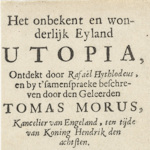
Well, you can’t argue with their timing. The Literature Museum has picked an eerily appropriate moment to present their latest exhibition: Utopias and Apocalypses.
- Presents literary imaginings of the future
- Accompanied by numerous exhibits: from 16th century bibles to modern science fiction books
- Includes the bundle of unbridled joy that is the Pandemic Reference Library
- Plenty of English information (in displays or on a tablet you can borrow)
- Just needs a normal museum ticket to view
- Runs Oct 8, 2020 – Apr 25, 2021
- See also:
An exhibition for our times

(Special exhibition in the Literature Museum © Österreichische Nationalbibliothek)
A utopia and an apocalypse essentially represent two ends of a spectrum, each reflecting a different balance between the hopes and fears of humanity.
Give a writer a pen and they’ll conjure up any number of imaginary and imagined worlds and futures. So, inevitably, authors through the centuries have turned their attention to such considerations. Some of the results have long become embedded in the public consciousness; think of such novels as Brave New World. Or 1984.
The compact Utopias and Apocalypses exhibition asks how these writers have perceived the future of life on earth and showcases the outcome of such literary endeavours: from aspirational utopian visions to technological predictions and dark visions of apocalyptic disasters.
The displays feature books, manuscripts and other items from the extensive collections of the National Library (and loans from other institutions).
Exhibition highlights
Historians credit Thomas More with the invention of the term, utopia, in the same-named book from 1516. A 1518 edition of that work appears in the exhibition.
Other literary joys include:
- The 1740 Accurata Utopiae Tabula (a map of some fictional land of milk and honey)
- A 1534 bible with its woodcuts illustrating the apocalyptic events of the Book of Revelations
- A valuable 1522 edition of Giovanni Bocaccio’s The Decameron, a collection of tales told by fictional narrators as they shelter from the Black Plague (an unpleasantly familiar concept right now)
- A 1720 German edition of Robinson Crusoe and a 1747 edition of Gulliver’s Travels
- A gorgeous (to me) 1954 classic Penguin edition of 1984
As you can tell from the last bullet point, the scope of the exhibition goes beyond the imaginings of medieval and Baroque authors and illustrators.
One section, for example, has books featuring the literary utopias and visions of the future conceived by women. The selection includes an 1823 edition of Mary Shelley’s Frankenstein (considered by many to be the first real work of science fiction), and books by Charlotte Perkins Gilman, Ursula K. Le Guin, or Virginia Woolf.
And if you’re feeling particularly downhearted, you can cheer yourself up with the novels in the Pandemic Reference Library, which all have viruses and plagues as a central thread.
The exhibition even moves beyond the literary domain on occasion. I spotted a 1926 poster for Fritz Lang’s Metropolis, small models of R2D2 and C3PO from Star Wars, and a rather impressive little art installation – Inseln der Seligen (GIER) – by Klaus Wanker.
Dates and tickets
Discover all our possible futures between October 8th, 2020 and April 25th, 2021. A normal ticket to the Literature Museum gets you into the special exhibition (or use a Vienna Pass for one-time free entry).
How to get to the exhibition
Look for the travel tips at the bottom of the Literature Museum page.
Incidentally, if you need a relaxing cup of coffee before the Apocalypse, one of Vienna’s oldest coffee houses is just around the corner: pop into Café Frauenhuber inside a building where Mozart and Beethoven once played.
Address: Johannesgasse 6, 1010 Vienna